First use of CLT in the Los Angeles Area
843 N Spring Street is a multi-use creative office and retail/restaurant space and the first mass timber project with cross-laminated timber (CLT) to be constructed in the Los Angeles area. It was fundamental gaining acceptance of CLT as a viable structural material under City of Los Angeles Building Code, and is presented as a case study for the sustainable benefits of adaptive reuse integrated with lightweight structures.
Structural Anatomy and the Local Code
The structure extends 5 stories above the existing ground-level podium and is comprised of a hybrid steel frame and CLT gravity system with concrete topping required for the diaphragm. With floor-to-floor heights ranging from 13 to 20 feet, and a total height of 74 feet, the lateral system consists of a mere 4 bays of special concentrically braced frames (SCBF) in each direction above the podium, all of which transition to special reinforced concrete shearwalls (SRCSWs) below the podium. Level 2 was constructed as a Type 1-A suspended two-way concrete flat slab, functioning as a fire separation between the mixed construction types. Under the 2016 California Building Code (CBC), the above-grade hybrid mass timber structure met the height and story limitations of Type III-B construction, allowing the beautiful CLT and steel framing to remain unprotected and on full display. In addition, the building sits on a sloped site across the street from the Chinatown LA metro station – the parking benefits afforded to transit oriented developments were crucial in the feasibility of this adaptive reuse project.
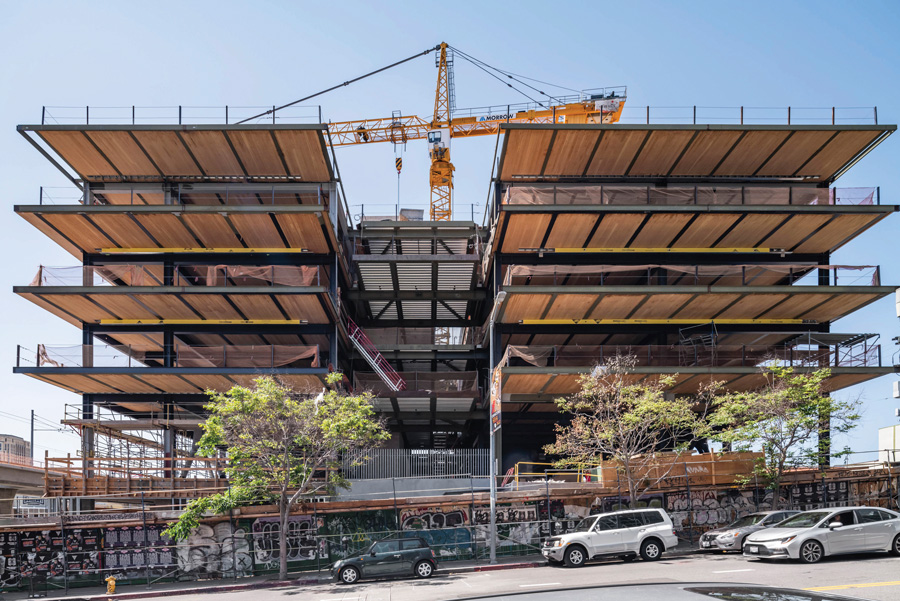
Adaptive Reuse
The adaptive reuse design maintained the existing concrete structure and masonry segments of the previous two-story commercial building occurring at L1 and below grade. The design intent called for the preservation and selected interventions to the existing slab-on-grade, foundation, concrete columns, basement walls, and L1 podium slab. The design provided the construction team with options for preserving the existing slab-on-grade and foundations by doweling in and encapsulating the existing foundations with a larger concrete area, where required, to account for increased loading of the new structure.
The new structure, framed with steel beams, steel columns and a thin concrete topping over a CLT deck, was integrated into the concrete podium by aligning the new column grid with the existing column grid, eliminating the need for deep transfer systems that would have compromised the existing below grade parking. The above-grade W14x steel columns aligned over the 14-inch diameter existing concrete columns that were strengthened to satisfy the increased demands. Strengthening involved exposure of the internal rebar cages and reconstruction of longer columns that were no wider than the existing to maintain the existing parking layouts. It was crucial to the feasibility of the project that the existing column widths be maintained, as any deviation would have resulted in fewer stalls than required by the local building code. In the end, parking requirements for this transit-oriented development were met with a combination of bike parking, parking stackers, and the existing stalls. Through preservation of the existing column grids and parking counts, we saved an entire additional level of parking slab, basement walls, thicker foundations, full demolition, and extensive excavation. This reduced project time, cost, and the environmental impact associated with wide-scale demolition and excavation.
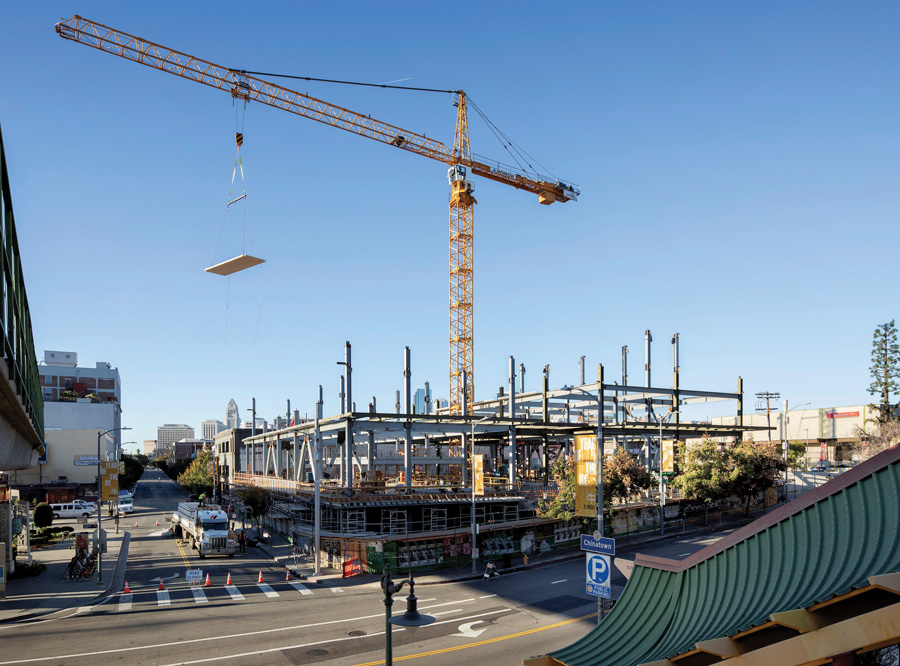
Photo Courtesy of Jeremy Bitterman / JBSA.
The Architectural design intent called for the use of SCBF’s above grade, in lieu of extending the below grade SRCSWs up to the new floors. With new steel lateral systems introduced above-grade, which transitioned to new or enhanced special concrete shearwall systems below grade, careful attention was given to the connection between these respective systems to ensure adequate and redundant load paths were provided. The connection between the respective steel and concrete systems was achieved by extending the steel SCBF columns down an additional level and developing them into the new or existing concrete shearwalls below. Where the steel SCBF columns required development into the existing below grade walls, it was provided with welded reinforcing and a combination of welded and mechanical splices were made with the existing basement wall reinforcing. At the new walls below, SCBF columns were extended into boundary elements and developed with a combination of welded studs and welded spliced reinforcing bars. With the thoughtful placement and integration of the new SCBF systems over the existing basement walls, we were able to engage a significant amount of the existing walls and footings to control uplift and distribute foundation loads over a large area, thereby minimizing the required foundation sizes. The design intent for preserving the existing structural elements, including the existing basement walls, concrete columns, and suspended concrete slab, saved approximately 1540 cubic yards of concrete.
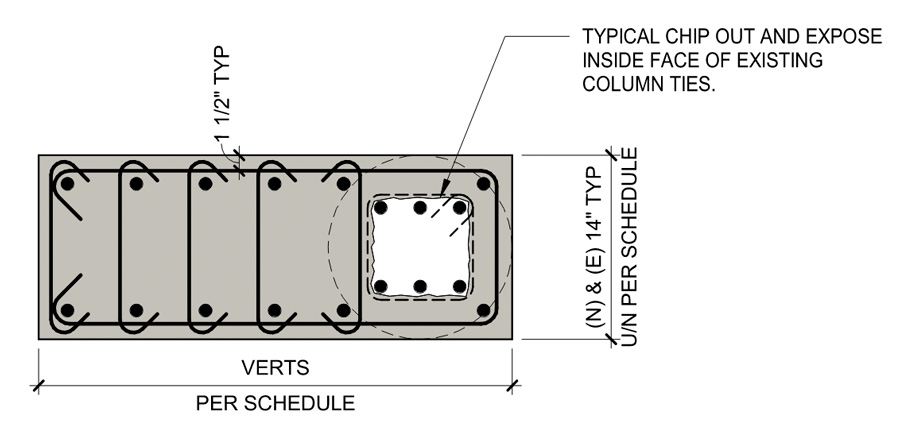
Materials and Construction Methods
Whenever possible, the team seized on opportunities to reduce the demolition of the existing structure and use it to the design’s advantage in resisting the new and additional loading demand. The lightweight nature of the CLT floors was crucial in allowing the design team to provide an option to avoid demolition of the existing foundations and opt for enlarging the existing foundations to meet the new load demands. Although CLT was listed as a building material in the building code at the time of design, it was not considered a viable diaphragm to resist lateral loads in Los Angeles due to the lack of official standardized in-place shear values. However, its use was functional for the gravity system and disproportionally contributed to the overall unique aesthetic beauty of the building. With 14-foot cantilevers rising out of the building structure along its wings, the astounding beauty of the CLT panels from the bottom of College Street is unparalleled.
As previously indicated, in addition to the warm aesthetic that the CLT deck produced, this type of floor construction allowed for a lighter structure in general. This secured the architectural intent of round HSS braces for the SCBF frames for which the team was striving. Any significant increase in the seismic mass, which would have easily been exceeded with either a steel or concrete framed system, would have forced the use of either rectangular HSS or Wide-Flange braces, neither of which was a viable option for completely exposed structural steel. The lightweight nature of the structure was directly correlated with preventing the required widespread demolition of the existing foundations and the excavation associated with new, deeper foundations. Had the structure been any heavier, the existing foundations would have failed in shear and forced the design team to demolish nearly the entire existing building. The lightweight properties of a CLT deck framed with steel beams also contributed to smaller concrete and steel column sizes. An 8% decrease in seismic mass compared to a traditional building led to an 11% decrease in steel frame quantity.
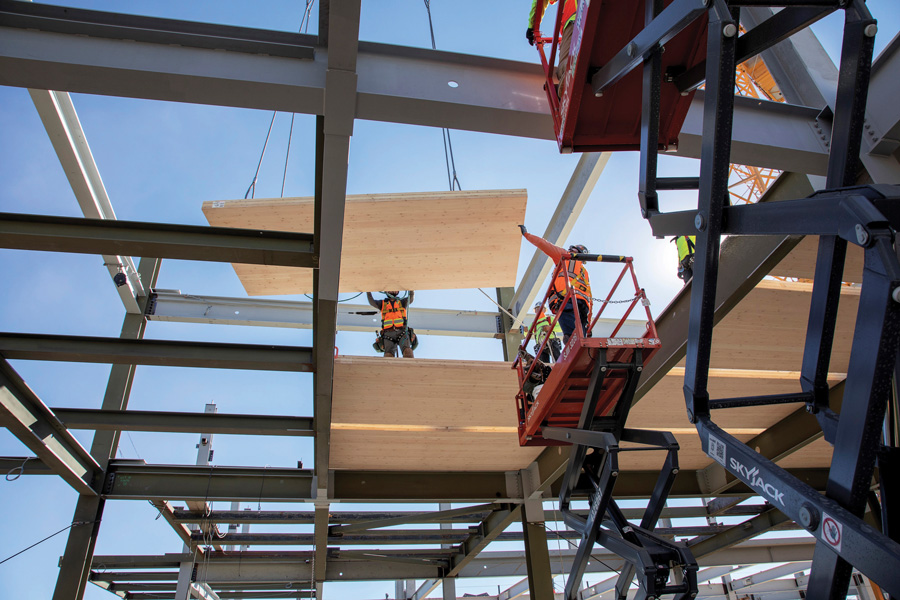
Sustainability and Carbon Sequestration
From a pure sustainability standpoint, the use of CLT was quite compelling. The carbon sequestration from the CLT decks used from Level 2 to the Roof equated to about 930,000 kilograms of carbon dioxide equivalent (kg C02-e) throughout the intended lifetime of the building. The average recycled content for steel manufactured in the United States is about 93% for hot-rolled structural shapes. The use of Wide-Flange beams and columns throughout contributed to 86% of the steel on the project being produced through electric arc furnace process (EAF), as opposed to its more polluting counterpart, basic oxygen furnace (BOF) process. Due to the Type III-B construction designation, the building could fully expose its steel and CLT framing, significantly reducing the embodied carbon associated with architectural finishes and fireproofing. Many aspects of the design came together to contribute to the building’s lower-than-average global warming potential (GWP):
- The use of CLT allowed for a relatively light structure when compared to conventional steel or concrete structures with similar bay sizes;
- Reuse of the bottom section of the building saved more than 31% of the total amount of concrete in the building;
- Reusing the existing concrete elements and strategically using the local parking code requirements prevented the project site’s widespread demolition and extensive excavation.
These seemingly small but meticulously coordinated design items all made significant contributions to reducing the embodied carbon of the building when compared to a standard office building. The design intent for reusing the existing elements alone accounted for approximately 480,000 kg CO2-e in global warming potential (GWP) savings. In addition, preserving much of the existing structure and preventing demolition and broad excavation led to an additional savings of 330,000 kg CO2-e.
Finally, the material savings associated with the prevention of an additional parking level accounted for approximately 360,000 kg CO2-e. These GWP savings, combined with the aforementioned carbon sequestration from the CLT panels, led to eliminating approximately 2,100,000 kg CO2-e from being released into the atmosphere. This would be the equivalent of the building occupants emitting no commuting transportation emissions for the first 12 years of the building’s operations.
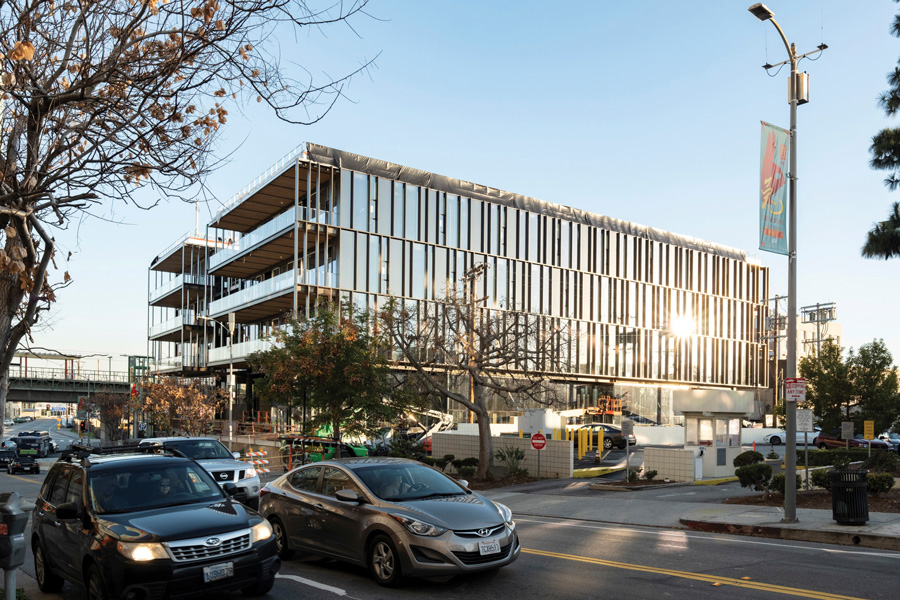
Conclusion
The 843 N Spring Street project provided a stepping stone for the CLT and adaptive reuse space in the Los Angeles market. The author’s firm is humbled to have taken part in such an iconic structure in historic Chinatown. It was foundational in providing a pathway for other buildings in the Los Angeles area to use CLT for both the gravity and lateral system. It further embodies a more sustainable way of looking at building design through the use of more sustainable materials, lighter materials, and the reuse of existing structural elements. All involved will be excited to see this building come to completion and open in the near future.■
